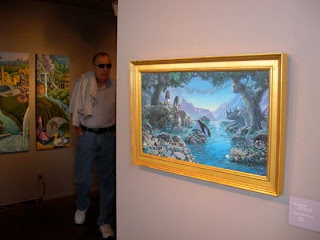











Variolization
While the H1N1 pandemic rages and our lawmakers debate the merits of national healthcare, my exhibit Outbreak: Plagues That Changed History, has a new home for the next three months: the National Museum of Health and Medicine in Washington, DC. The 30 paintings and 7 maps are from my book Outbreak, published by Crown in 2005. As you may recall from previous posts, Outbreak focuses on six diseases: bubonic plague, smallpox, tuberculosis, cholera, yellow fever and influenza, with sidebars on toxoplasma, malaria and AIDS. As the title suggests, this is not just a recounting of epidemics, but a social history of public health through the lens of disease.
Armistice Day, San Francisco, 1918
The NMHM started out in 1862 as the Army Medical Museum, a division of the Armed Forces Institute of Pathology. It is on the campus of the Walter Reed Army hospital. To complement the paintings, the staff selected a few items from the Museum's collection of 24 artifacts. Visitors are greeted by a life-size costumed model of a beak-masked plague doctor. The Museum also installed four exhibit cases with artifacts and specimens related to the diseases in the book—a wax model of the face of a 15-year-old boy with lesions resulting from small pox, a tuberculosis-prevention brick engraved with the words, “Don’t spit on sidewalk ,” a lung that shows signs of bronchopneumonia resulting from the 1918 influenza pandemic, and the microscope of Walter Reed himself, the man who led the team that determined the etiology of yellow fever.
Memento Mori
The show opened on Halloween (it runs through January 22). For the opening, children made and wore medieval plague masks stuffed with dried rosemary, and created macaroni skeletons engaged in the "Dance of Death."
I'll be speaking at the Museum on December 5.






After reading the story, Barnard sat to paint an image from the book. He described his layering technique using acrylic and oil paints while intermittently narrating a sneak peak at his forthcoming book for fall 2010, of which he is both writer and illustrator, The Genius of Islam: How Muslims Made the Modern World, from Knopf Publishing. The new book will describe the magnificent innovations Muslims have made throughout history, from crank-shafts to sandpaper.